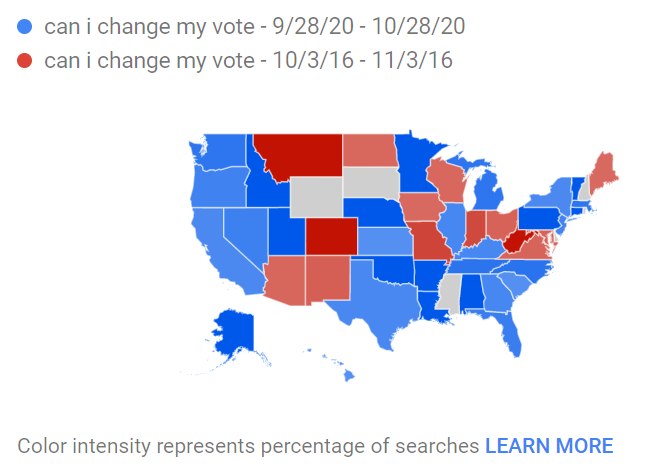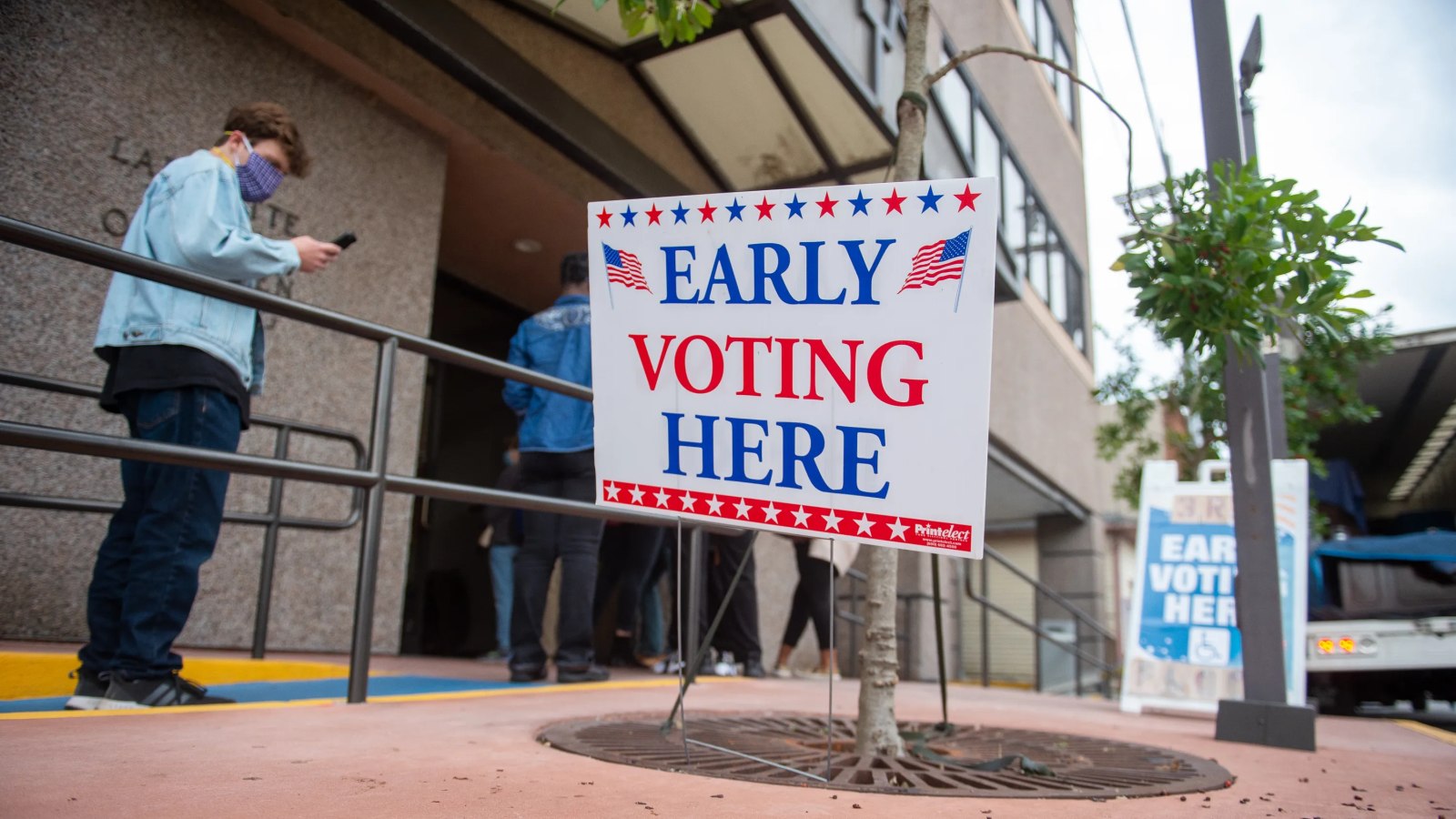With such a heavy amount of early voting, being encouraged now more than ever due to Covid-19, it’s only natural that a higher percentage of people might ask if they can somehow change their early vote. In most states, there is no way to change your early vote, either in-person or mail-in, but some states do allow changes.
The question has arisen because some researcher noticed that Google searches for “can I change my vote” have skyrocketed in the past week. Which way these changes are going is anyone’s guess. It could be Trump voters who cast an early vote for his re-election, only to decide now that they favor Biden. It could be early Biden voters who were ready to give Trump the boot, but are now having second thoughts. Whatever the case may be, there is massively heightened interest in changing early votes in 2020 compared to 2016.
Here is the current chart showing a comparison of the term between 2020 and 2016. Note that the line colors of red and blue are not partisan in nature, just the colors that Google selected by default.
The blue line–again, no partisan relation–is searches for “can I change my vote” in 2020. The red line–no partisan relation–is searches for “can I change my vote” in 2016.

If you’d like to explore the data yourself, here’s the link directly to the comparison on Google Trends.
The increase is dramatic. Google normalizes the number so a value of 100 indicates peak interest in the term. Back in 2016, the normalized value peaked at a level of 31 at the same number of days before Election Day, which was Nov. 8. Based on those numbers, there is nearly a 225% increase in 2020 for “can I change my vote” compared to 2016.
Breaking this information down by region can give us a little more data, but not much more insight into which party is benefitting from the question of changing an early vote.
Once again, ignore the red and blue in terms of partisan meaning. The red states below had a higher level of “can I change my vote” in 2016 compared to the blue states below which show a higher level of “can I change my vote” in 2020:

There are many swing states crucial to both candidates in 2020, such as Florida, North Carolina, Pennsylvania, Michigan, and Minnesota, that are showing high interest in asking whether an early vote can be changed.
According to Business Insider, only a small number of states actually allow you to change in-person or mail-in early voting. Here’s the rundown of how you might be able to change your vote depending on state laws and, in some cases, local laws regarding invalidating or
“spoiling” your vote:
In Michigan, absentee voters can request that local election officials invalidate or “spoil” their first ballot and submit a new one until 5 pm on the Friday before Election Day or in-person until Monday at 10 am the day before Election Day.
Wisconsin absentee voters can “spoil” their ballot and request a new one or vote in-person before certain deadlines, according to a 2020 memo memo put out by the Wisconsin Elections Commission.
In New York, voters can cast a new ballot in-person either early or on Election Day and ask that their initial ballot be invalidated.
Casting new ballots in permitted in some Connecticut towns, but it varies across the state.
In New Hampshire, voters can request a new ballot if election officials determine there’s enough time to do so, and they can vote in-person on Election Day if the initial ballot was not yet counted.
In several other states, including Pennsylvania, Illinois, Delaware, New Mexico, Idaho, Indiana, Arkansas, and Mississippi, voters are allowed to “spoil” a ballot and request another, but only if the initial ballot hasn’t yet been returned or, in some cases, processed.
The deadline to invalidate a ballot and request another has already passed in Minnesota.
Minnesota is noteworthy since it’s a state President Trump narrowly lost to Hillary Clinton in 2016. For Minnesotans, the deadline to change an early vote has passed, so the rest is history there.
Pennsylvania could be noteworthy also since it’s a state both candidates are campaigning heavily for. Each candidate has paths to victory that become much easier if Pennsvualnnia is in their “win” column. Votes there can be changed if they haven’t already been processed.
Michigan and Wisconsin are the other two swing states in the mix where voters do have a chance to renege and change an early vote. In each case, voters need to contact their local board of election office or state election office to get details on deadlines and procedures for doing so.
New York may be the easiest state to change an early vote. If you already voted by mail, simply showing up and casting a vote on Election Day in-person will automatically invalidate your early mail-in vote. Voters can also show up early in-person and ask that their previous ballot be rejected.
Ultimately, this is just an interesting tidbit of information in a year of out-sized early voting. Some voters started casting ballots before the first debate on Sept. 29, a day which seems like eons ago now. It’s natural that given the amount of time voters have had to digest news and hem and haw over their choice for weeks now, some may just be curious about changing a vote, while others might be serious about it.
The likelihood is that only a very small percentage will end up being changed, so it probably wouldn’t affect the outcome either way. It would, however, be interesting to see some data from state election boards about how many vote changes occurred in the final week.
Donate Now to Support Election Central
- Help defend independent journalism
- Directly support this website and our efforts
